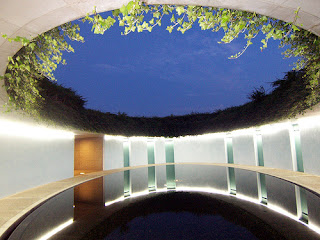Introduction of Kagawa
Kagawa is
situated in the northeastern part of Shikoku. The Sanuki Mountain Range, a
chain of 1,000-meter-high mountains including Mt. Ryuo-zan, the highest of all
at some 1,060 meters above sea level, runs through the southern part of the
prefecture. The Sanuki Plains stretch out to the north, and the Seto Inland Sea
is dotted with 116 islands of all sizes, including Shodo-shima Island.Since early
times, Kagawa has been known for the production of cotton, sugar and salt,
together called "Sanuki Sanpaku," or Sanuki Three Whites. Takamatsu
City, which was a castle town in the Feudal Age, prospered as an important
center of transportation for these products.
The
Bisan-Seto Sea area, with its 690-kilometer-long coastline fronting the Sea of
Japan and a variety of islands sitting in the serene waters, boasts of natural
scenery so beautiful that it was designated as Japan's first national park in
1934. Kotohira-gu Shrine, intimately nicknamed "Konpira-san" by the
local people, drew many visitors as a center of worship for common people from
the 17th through 19th centuries. Today, about four million people a year visit
the shrine.
Shodo-shima
Island, known as the place where olive cultivation started in Japan, has
beautiful valleys such as Choshikei and Kankakei, Shodoshima Olive Park that
resembles a location along the shore of the Mediterranean, and many other
interesting places worth visiting.
Below are the attractive places in Kagawa:
Marugame Castle
Marugame Castle (Marugame-jo) was
completed by the daimyo Ikoma Chikamasa, who governed the present Kagawa
Prefecture at the beginning of the 17th century. The castle used to be
surrounded by a double moat. The outer moat has now been filled in, but the
inner moat near the donjon remains as it was in the old days, and the donjon has
been designated an Important Cultural Property. Visitors are greeted by the
three-tiered donjon after climbing up a steep incline with a view of the
beautifully curved stone walls.
Admission Fee: 200 yen
Closed: Dec.
25-31
Access: JR
Marugame Station/On foot/10 min.
Address: 1
Marugame-shi, Kagawa
Ritsurin Koen Park
Ritsurin Koen is a
park located in the city of Takamatsu, and covers around 75 ha. Landscaping
began in 1642 and is said to have taken 100 years to complete. In the garden
are six ponds and 13 artificial hills called tsukiyama. The garden, set against
the backdrop of the mountain Shiun-zan, is evocative of a Japanese painting.
The technique of using scenery such as mountains in the distance in the design
of a garden is known as shakkei. The garden in the southern part of the park is
in a purely Japanese style. A small house known as Kikugetsu-tei used for tea
ceremony and located by the pond is known as an arbor for enjoying the beauty
of the full moon in autumn. The garden in the northern part of the park has
undergone major restoration and is now a Western-style garden.
Admission Fee: 400
yen
Operation: Open
throughout the year
Access: JR
Ritsurin-koen Kitaguchi Stn./3-min. walk
Address:
1-20-16 Ritsurin-cho, Takamatsu-shi, Kagawa
Benesse Art Site Naoshima
The
Benesse Art Site Naoshima is a series of art projects developed on Naoshima
Island, located in the Seto Inland Sea. Its facilities includes the Benesse
House, the Chichu Art Museum, the Art House Project, and Honmura Lounge &
Archive; their site-specific activities and artworks focuses on contemporary
art in harmony with the natural beauty and local culture of Naoshima. The
Benesse House was designed by acclaimed Japanese architect Tadao Ando. The
Chichu Art Museum was initially designed to display Claude Monets
"Water-Lily Pond" (2m x 6m) in its unique way, and now, Monet's Room,
with its white walls, is not to be missed. The works of James Turrell and
Walter De Maria are also exhibited.'
Admission Fee: 1,000
yen (Benesse House), 2,000 yen (Chichu Museum)
Operation: The
Benesse House is open throughout the year. The Chichu Museum is closed on
Mondays (if the Monday is a national holiday, the following Tuesday),
maintenance period
Access: JR
Takamatsu Station/On foot/5 min./Takamatsu Port/Shikoku Kisen Ferry/50
min./Miyanoura Port/Naoshima Town Bus/20 min./Benesse House Bus Stop/On foot/1
min.
Address: Kotodanchi,
Naoshima-cho, Kagawa-gun, Kagawa
Sohonzan Zentsu-ji Temple
Zentsu-ji,
located in the city of Zentsuji, Kanagawa Prefecture, was built at the
birthplace of the priest Kukai, who founded the Shingon sect of Buddhism, and
was posthumously known as Kobo Daishi. Kukai is said to have built this temple
at the residence of his father on returning from his studies in China. The
temple ranks in importance alongside To-ji in Kyoto and Koya-san in Wakayama,
and is regarded as one of the major memorials to Kobo Daishi. In the temple
grounds is a well in which Kukai was given his first bath as a newborn baby.
Admission Fee:
Houmotsu-kan (Treasury Hall): 500 yen (regular fee)
Access: JR
Zentsu-ji Stn./20-min. walk
Address: 3-3-1
Zentsuji-cho, Zentsuji-shi, Kagawa
Kotohira-gu
Shrine
Kotohira-gu,
located in Kotohira-cho, Kagawa Prefecture, is sacred to Omononushi-no-Kami and
Emperor Sutoku. While the date of its establishment is not known, the shrine is
known to have been the object of veneration from early times. The guardian
deity for navigation and fishing, as well as the headquarters of many branch
shrines, Kotohira-gu is known affectionately across the country as
"Konpira-san." The Juichimen-Kannon (an eleven-faced statue of a
standing goddess of mercy) has been designated an Important Cultural Property
by the Japanese government.
Admission Fee:
Free
in the shrine precincts
Omote-Shoin:
800 yen
Homotsu-Kan(Treasury
Hall):800 yen
Access: JR
Kotohira Stn./20-min. walk
Address: 892-1
Kotohira-cho, Nakatado-gun, Kagawa






No comments:
Post a Comment